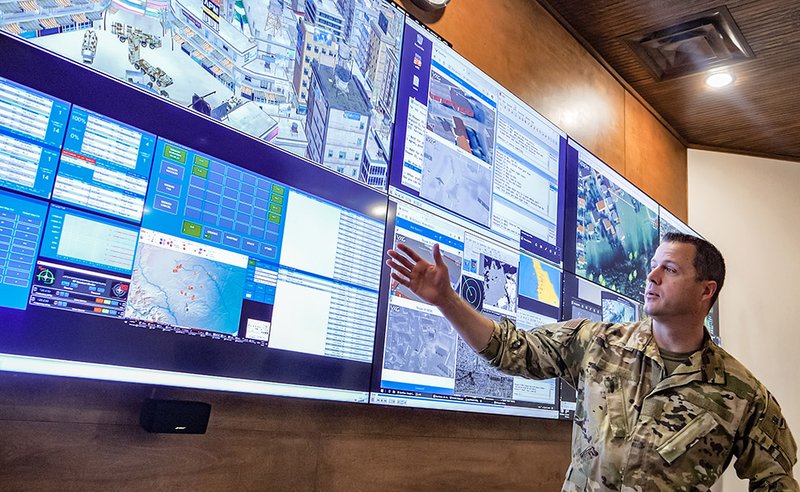I/ITSEC 2022: HII enhances human-machine teaming training for US Army
HII’s crewed-uncrewed teaming training system has been tested with the US Army’s Apache, but it can operate with any autonomous system with the right equipment to receive data.
CAE recognises that working together with digital ecosystem partners allows it to bring different ways of thinking to the table. (Photo: CAE)
CAE demonstrated its Joint All-Domain Operations (JADO) and Single Synthetic Environment (SSE) capabilities at I/ITSEC 2022 last week in Orlando.
Speaking to Shephard at the show, CAE senior director of SSE and military applications Christopher Coates and VP for SSE and immersive technology Joe Armstrong said the company’s SSE is not a simulation, but ‘a real-world metaverse'.
Coates explained that the company’s plan is to recreate the real world to allow users and commanders to plan and make decisions more efficiently.
CAE to help boost Australian Navy personnel numbers
B-52: new training options for an old bomber detailed at I/ITSEC 2022
‘It [the SSE] is not a simulation, it is not a model, it’s the real world. It includes the physical aspects of the world, so all of the terrain, all of the built-up infrastructure, critical infrastructure, the electromagnetic spectrum and the whole population wherever they are and wherever they are moving,’ he said.
Armstrong added that the company started working on the SSE nearly three years ago if one factors in the combination of all the different pieces of technology that began forming the base of the project.
The speed of evolution and investment in aerospace and defence is no longer sufficient to achieve the next generation of technology.— CAE VP for SSE and immersive technology Joe Armstrong.
He explained that in the SSE CAE is building ‘every single layer of data is fully integrated, which means that if I have a change due to a change in the environment, it propagates through the entire layer system'.
CAE is looking at data as an ecosystem where everything is related. If an explosion happened in the middle of a city in the simulated system, for instance, the SSE would not only show the blast with its pressure wave, but it would destroy buildings, injure people and disrupt the infrastructure, he said.
Armstrong said that CAE recognises that the future of these technologies will be ‘fundamentally driven by bringing different industries together’ and no single company can exist in a vacuum.
‘The speed of evolution and investment in aerospace and defence is no longer sufficient to achieve the next generation of technology. Drawing on technology that comes out of the gaming world, the research on climate change and so on, that is the real future,’ Armstrong said.
Coates added that it is clear that innovation is no longer coming from defence, but from industry.
Armstrong went on to say that CAE recognises that working together with digital ecosystem partners allows it to bring different ways of thinking to the table.
‘If we do it on our own, we will never change, we won’t innovate because we don’t have that experience in our own worldview that has been created over decades.’ The representatives said this is something defence needs to recognise as well.
The military is constantly being accused of having major institutional, cultural and bureaucratic problems that make it too predictable and slow to change and adapt.

CAE integrated tactical trainers with AI-driven assessment of operations, feedback on cognitive performance and an all-domain/near-peer virtual environment. (Photo: CAE)
CAE also demonstrated its Joint All-Domain Operations (JADO) at I/ITSEC for the first time.
JADO brings together technologies from modelling and simulation, AI, training system integration, and human-machine teaming to provide a complex, immersive experience.
At the show, CAE integrated tactical trainers, AI-driven assessment of operations, feedback on cognitive performance, and an all-domain/near-peer virtual environment, to show how training and mission rehearsal can be taken to the next level.
CAE said that JADO is built on the company's Virtual Intelligence Surveillance & Reconnaissance Training Application (VISTA), which provides real-time dynamic feeds from virtual C4ISR assets directly to intelligence screeners and C2 terminals.
VISTA can provide stand-alone training access for mission rehearsal or operational planning, starting with initial preparation of the operational environment. It also supports real-time interdiction support, high-value individual targeting and strike and all domain near-peer targeting.
VISTA can run on the cloud or at enterprise level and is compliant with the USAF’s Distributed Mission Operations (DMO) standards and can link multiple US and coalition partners for small- or large-scale training and exercises.
Due to its containerised architecture, it can be installed as part of a centralised or local cloud system to scale support across any JADC2 enterprise.
Shephard's I/ITSEC 2022 coverage is sponsored by:


HII’s crewed-uncrewed teaming training system has been tested with the US Army’s Apache, but it can operate with any autonomous system with the right equipment to receive data.

The Shephard Media news team looks at all the developments in the military training and simulation world, and discovers the trends and challenges in seabed warfare.

Leonardo is developing the Smart Chair system in its Battle Lab that allows for advanced pilot training for multi-domain scenarios and can potentially 'replicate a sixth-generation fighter jet cockpit'.

Boeing's T-7A Red Hawk simulator and maintenance training system will allow pilots and ground crew to train in novel ways as soon as the platforms are delivered.

Saab has increased training activities across core markets, opened combined training centres and is set to grow its business further.

The US Army's Project Manager Synthetic Environments is overseeing two major re-bid programmes.